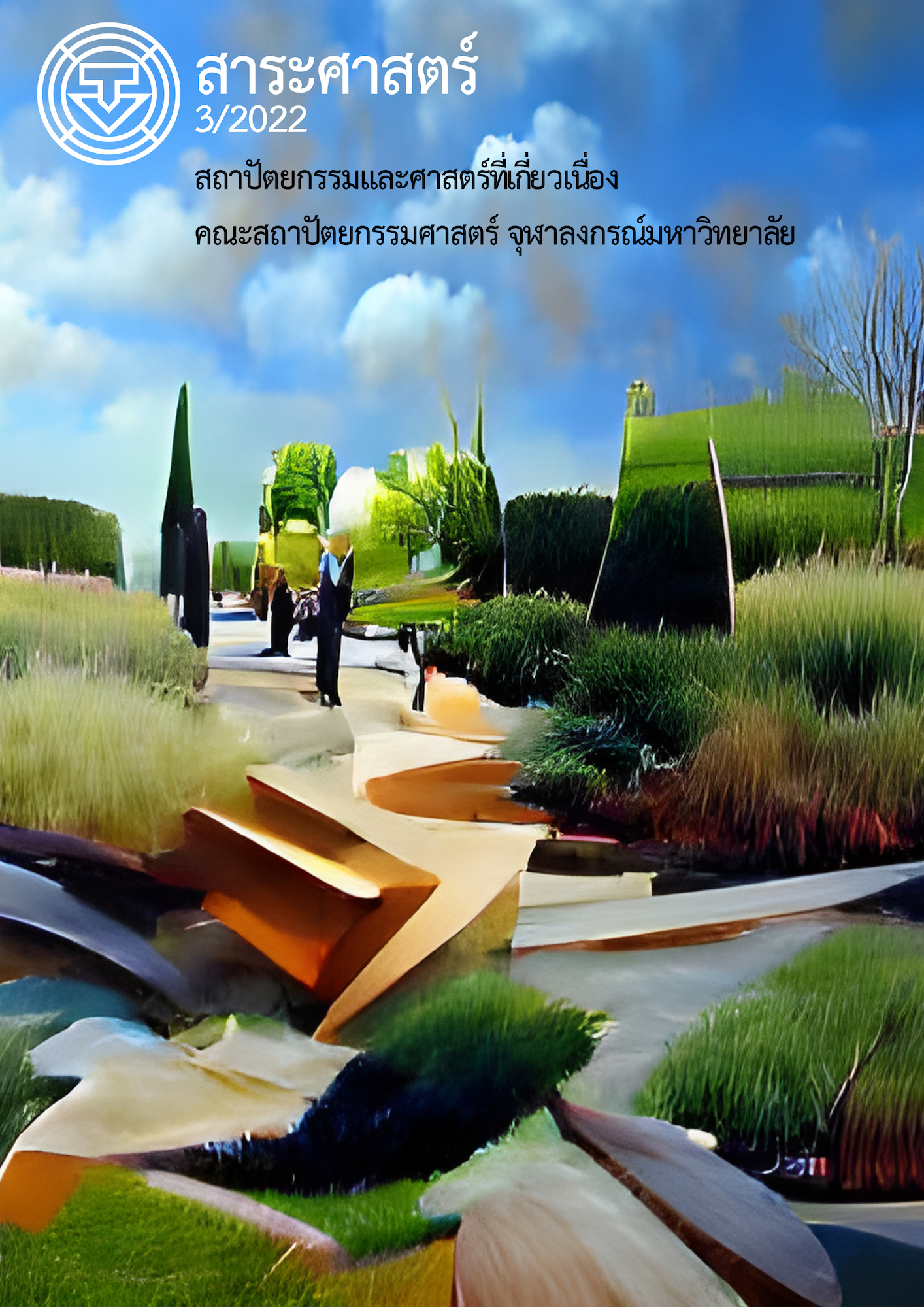Living Behavior and Desirable Housing Styles of Gay Males, A Case Study of Relatively Middle-Income Groups
Main Article Content
Abstract
Thailand is receptive to gender diversity including gay males, which is defined as a population of LGBT individuals, with upper-middle incomes. There is a distinct preference for consuming, as well as a selection of distinct locations and activities. Dwelling is also one of them, this can be considered more accessible for people in the LGBT community nowadays than in the past. Therefore, the research is interested in examining the ideal housing qualities for the gay males with upper-middle incomes. The research objectives were to study the relationship between the socio-economic as well as the dwelling pattern of the gay males with upper-middle incomes and to study the relationship of results, in gay males who have medium to high income, residential criteria, which are considered of near their working places, facilities, and transportation.
The research found that most of the gay males with upper-middle incomes earn over 100,000 baht per month, and the majority of their dwellings are condominiums, which are differentiated into two types: nearby the facilities and nearby the working areas with accessibility to the electric train as the main mode of transit. In terms of dwelling pattern, it was found that 1) this group of gay males selection characteristic is choosing a residence near the working areas 2) since a group of gay males relationship characteristics is temporary, they need to choose convenient accommodations that fit the activities and destinations they intend to travel 3) as this group of individuals has upper-middle incomes, their dwelling is greater in size based on their incomes and capacity to afford admirable housing 4) there are two classifications of future housing planning. The first classification will be purchasing larger dwellings in the future because it is correlated with higher incomes, enabling them to buy larger residences nearby the working areas, while the second classification will be selecting residences nearby the facilities, which will be the current places as they already selected the size and style of dwellings that are appropriate for long-term living.
In conclusion, gay males will be content with dwellings that enable them to be in accordance with activities that they consider suitable for their lifestyle. It was also found that living nearby the working areas and nearby to facilities were preferred. Both of these characteristics have uncomplicated access to transportation. If the selection criteria are suitable, this group will also have the ability to the ideal dwellings.p.
Article Details
References
กรมธนารักษ์. (2565). สรุปราคาประเมินทุนทรัพย์ที่ดินเพื่อใช้ในการจดทะเบียนสิทธิและนิติกรรมปี 2559-2562 จังหวัดกรุงเทพมหานคร. สืบค้นเมื่อ 5 เมษายน 2565, จาก https://www.treasury.go.th/th/summary-of-land-valuation/
กิ่งรัก อิงคะวัต. (2540). รูปแบบการดำเนินชีวิต พฤติกรรมการบริโภค และพฤติกรรมการเปิดรับสื่อของกลุ่มชายรักชายในเขตกรุงเทพมหานคร. (วิทยานิพนธ์ปริญญามหาบัณฑิต, จุฬาลงกรณ์มหาวิทยาลัย).
คมฉัตร วุฒิโรจน์. (2534). ผ่าโลกเกย์. กรุงเทพมหานคร: สำนักพิมพ์กรุงสยาม.
โครงการพัฒนาแห่งสหประชาชาติ. (2557). รายงานบริบทของประเทศไทย การศึกษาทบทวนและวิเคราะห์กฎหมายและสภาพแวดล้อมทางสังคมที่เกี่ยวข้องกับองค์กรภาคประชาสังคมที่เป็นผู้มีความหลากหลายทางเพศ โดยกระบวนการการมีส่วนร่วม. สืบค้นเมื่อ 14 มีนาคม 2565, จากhttps://www.usaid.gov/sites/default/files/documents/1861/Being_LGBT_in_Asia_Thailand_Country_Report_Thai_Language.pdf
ชนทยา สร้อยโมรา. (2559). วิถีชีวิตของกลุ่มชายรักสองเพศในเขตบางแค. (วิทยานิพนธ์ปริญญามหาบัณฑิต, มหาวิทยาลัยศิลปากร).
ชุติภาส อุดมสุด. (2560). การศึกษาทัศนคติของกลุ่มชายรักชาย(เกย์) ที่มีผลต่อการเลือกซื้อเสื้อผ้าแบรนด์เนมเพื่อการส่งเสริมสถานะทางสังคม. (วิทยานิพนธ์ปริญญามหาบัณฑิต, มหาวิทยาลัยธรรมศาสตร์).
ธนาคารโลกสำนักงานประเทศไทย. (2562). การมีส่วนร่วมทางเศรษฐกิจของกลุ่ม LGBTQ ในประเทศไทย. สืบค้นเมื่อ 14 มีนาคม 2565, จาก https://documents1.worldbank.org/curated/en/319291524720667423/pdf/124554-v2-main-report-Economic-Inclusion-of-LGBTI-Groups-in-Thailand-Report-Thai-Version-PUBLIC.pdf
บริษัท เทอร์ร่า มีเดีย แอนด์ คอนซัลติ้ง จำกัด. (2564). อสังหาฯเจาะอำนาจซื้อLGBT ‘พร้อมจ่าย’ตอบโจทย์ไลฟ์สไตล์.สืบค้นเมื่อ 8 กันยายน 2564, จาก https://www.bangkokbiznews.com/news/detail/933909
Baania. (2562). เทรนด์การเติบโตของอสังหาฯสำหรับกลุ่ม LGBTQ+.สืบค้นเมื่อ 8 กันยายน 2564, จาก https://www.baania.com/t h/article/เทรนด์การเติบโตของอสังหาฯสำหรับกลุ่ม-lgbtq+-article_4598
The Bangkok insight. (2563). เปรียบเทียบชีวิตคู่ และสมรสเท่าเทียม คล้ายแต่ไม่เท่ากัน. สืบค้นเมื่อ 8 กันยายน 2564, จาก https://www.thebangkokinsight.com/news/politics-general/general/391568/
ปรภัต จูตระกูล. (2559). รูปแบบการดำเนินชีวิต การเปิดเผยตนเองในเฟสบุ๊ก และพฤติกรรมการซื้อสินค้าและบริการทางออนไลน์ของกลุ่มชายรักชาย (เกย์).(วิทยานิพนธ์ปริญญามหาบัณฑิต, สถาบันบัณฑิตพัฒนบริหารศาสตร์).
พัชนี เชยจรรยา, เมตตา วิวัฒนากุล และ ถิรนันท์ อนวัชศิริวงศ์. (2538). แนวคิดหลักนิเทศศาสตร์ (พิมพ์ครั้งที่ 4). กรุงเทพมหานคร: สำนักพิมพ์ข้าวฟ่าง.
Line Today. (2063). ธนาคารที่สามารถให้กลุ่มผู้มีความหลากหลายทางเพศปล่อยกู้ได้.สืบค้นเมื่อ 1 พฤษภาคม 2565, จาก https://today.line.me/th/v2/article/2Vz0rP
วรยุทธ พายพายุห์. (2561). การศึกษาการใช้ประโยชน์และความพึงพอใจของแอปพลิเคชันหาคู่บนโทรศัพท์มือถือของกลุ่มชายรักชาย(เกย์). (วิทยานิพนธ์ปริญญามหาบัณฑิต, สถาบันบัณฑิตพัฒนบริหารศาสตร์).
The standard. (2563). White Party Bangkok มหกรรมดนตรีสำหรับชาว LGBTQ+ พร้อมที่จะระเบิดความมัน-ต้อนรับปีใหม่. สืบค้นเมื่อ 8 กันยายน 2564, จาก https://thestandard.co/white-party-bangkok-lgbtq/
อรพินท์ ศักดิ์เอี่ยม. (2537). การใช้ประโยขน์และความพึงพอใจที่เด็กได้รับจากการชมรายการโทรทัศน์สำหรับเด็ก.(วิทยานิพนธ์ปริญญามหาบัณฑิต, จุฬาลงกรณ์มหาวิทยาลัย).
L'Officiel Hommes Thailand Club. (2561). บทสัมภาษณ์พิเศษกับ gCircuit. สืบค้นเมื่อ 8 กันยายน 2564, จาก https://www.siam2nite.com/th/magazine/lifestyle/item/857-gcircuit-founders-share- beginnings-of-the-company-history-of-meeting-each-other-and-thoughts-on-gay-relationships
อันธิกา แจคเกอลีน ไคลน์. (2546). กระบวนการเปิดเผยตัวเองที่เป็นรักร่วมเพศ. ขอนแก่น: คณะแพทยศาสตร์ มหาวิทยาลัยขอนแก่น.
Assael, H. (1998). Consumer behavior and marketing action. Cincinnati, OH: Southwestern College.
Eastman, J. K., Goldsmith, R. E., & Flynn, L. R. (1999, July). Status consumption in consumer behavior: Scale development and validation. Journal of Marketing Theory and Practice, 7(3), 41-52.
Evening Standard UK. (2019). Britain’s first LGBT+ retirement village.Retrieved September 8, 2021, from https://www.standard.co.uk/homesandproperty/property-news/lgbt-retirement-village-london-Vauxhall-b921808.html
Hawkins, L. D. & Coney, K. A. (2001). Consumer behavior: Building marketing strategy. Boston, MA: McGraw- Hill.
Mason, R. (1992). Modelling the demand for status goods. Salford: Association for Consumer Research, Department of Business and Management Studies, University of Salford.
Misterband B. (2019). Popular gay accommodation in Bangkok, Thailand. Retrieved September 8, 2021, from https://www.misterbandb.com/s/bangkok-bangkok-province-thailand
Plummer, J. T. (1984, January). The concept and application of lifestyle segmentation. Journal of Marketing, 38(1), 33-37.
Reiffenstein, Tim. (2016). Inclusivity and othering in Montréal’s gay village in Canada. (Doctoral dissertation, Concordia University, Montreal, Canada).
Smock, A. D., Ellison, N. B., Lampe, C., & Wohn, D. Y. (2011). Facebook as a toolkit: A uses and gratification approach to unbundling feature use. Retrieved September 8, 2021, from http://www.journals.elsevier.com/computers-in-human-behavior/ https://doi.org/10.1016/j.chb.2011.07.011
Solomon, M. R. (1994). Consumer behavior: Buying having and being (2nd ed.). Boston: Allyn and Bacon.


